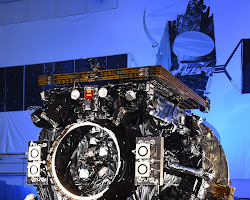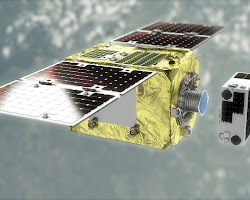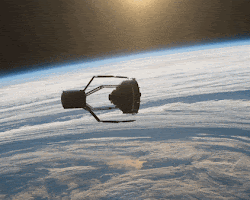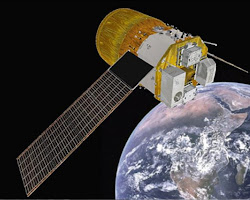Saturday, July 29, 2023
Tuesday, July 18, 2023
ESA Moves Ahead With In-orbit Servicing Missions
In-Orbit Servicing (IOS) refers to extending the life or functionalities of spacecraft that are already in orbit. This can be done by performing maintenance, adjusting a spacecraft’s orbit, changing the direction it is facing, providing more fuel, or even changing or upgrading the instruments onboard.
There are a number of technologies being developed for in-orbit servicing of GEO satellites. These include:
- Robotic arms: Robotic arms are being developed that can be used to grapple and manipulate satellites in orbit. These arms can be used to perform a variety of tasks, such as refueling, repairing, and upgrading satellites.
- Automated docking systems: Automated docking systems are being developed that can be used to dock two satellites together in orbit. These systems can be used to transfer supplies, personnel, or equipment between satellites.
- On-board sensors: On-board sensors are being developed that can be used to monitor the health of satellites in orbit. These sensors can detect problems with satellites before they fail, and can also be used to guide robotic arms and docking systems.
The economics of in-orbit servicing of GEO satellites are still being developed. However, there are a number of potential benefits to this technology, including:
- Reduced costs: In-orbit servicing can reduce the cost of launching new satellites by extending the life of existing satellites.
- Improved performance: In-orbit servicing can improve the performance of existing satellites by upgrading their payloads or components.
- Increased flexibility: In-orbit servicing can increase the flexibility of satellite operators by allowing them to customize their satellites to meet changing needs.
The challenges to in-orbit servicing of GEO satellites include:
- The high cost of development and deployment: The development and deployment of in-orbit servicing technology is very expensive.
- The complexity of the operations: In-orbit servicing operations are very complex and require a high degree of precision.
- The risk of failure: The risk of failure is high for in-orbit servicing operations. If a servicing operation fails, it could damage or destroy the satellite being serviced.
Despite the challenges, there is a growing interest in in-orbit servicing of GEO satellites. The potential benefits of this technology are significant, and the costs are expected to come down as the technology matures. As a result, in-orbit servicing is likely to become an increasingly important part of the future of satellite operations.
There are a number of agencies and companies that are developing and deploying in-orbit servicing solutions. Some of the most active players in this space include:
- SpaceLogistics: SpaceLogistics is a subsidiary of
Northrop Grumman that is developing a robotic servicing vehicle (RSV)
called the Mission Extension Vehicle (MEV). The MEV has been used to
extend the life of two geostationary satellites, Intelsat 901 and
Eutelsat 172B. SpaceLogistics MEV
- Northrop Grumman: Northrop Grumman is also
developing a satellite servicing system called the Space Infrastructure
Servicing (SIS) vehicle. The SIS vehicle is designed to refuel, repair,
and upgrade satellites in geostationary orbit. Northrop Grumman SIS vehicle
- MDA: MDA is a Canadian company that is developing a satellite servicing system called the Robotic Orbital Servicing Vehicle (ROSV). The ROSV is designed to refuel, repair, and upgrade satellites in geostationary orbit.
- Kepler Space Technologies: Kepler Space
Technologies is a company that is developing a satellite servicing
system called the Kepler ACES. The Kepler ACES is designed to refuel,
repair, and upgrade satellites in low Earth orbit. Kepler Space Technologies Kepler ACES
- Astroscale: Astroscale is a Japanese company that
is developing a satellite servicing system called the RemoveDEBRIS. The
RemoveDEBRIS is designed to remove space debris from orbit. Astroscale RemoveDEBRIS
These are just a few of the agencies and companies that are developing and deploying in-orbit servicing solutions. As the technology matures, it is likely that more players will enter this market.
In addition to these companies, there are also a number of government agencies that are involved in the development of in-orbit servicing solutions. These agencies include:
- NASA: NASA is developing a number of in-orbit
servicing technologies, including the Restore-L mission, which will
refuel the Landsat 7 satellite. NASA Restore-L mission
- ESA: ESA is developing a number of in-orbit
servicing technologies, including the CleanSpace-1 mission, which will
demonstrate the ability to capture and deorbit a small satellite. ESA CleanSpace-1 mission
ESA Moves Ahead With In-orbit Servicing Missions: Isn’t it strange that when satellites run out of fuel or a single component breaks down, we just discard them? ESA and European industry have joined forces to make sure that our satellites can live on. ESA has conducted extensive work on IOS, including as part of its Clean Space initiative for the removal and prevention of space debris. As part of this research, ESA Preparation invited industry partners to outline their vision of Europe’s first IOS mission, to be launched as early as 2028.
Astroscale, ClearSpace, D-Orbit and Telespazio (collaborating with Thales Alenia Space) were given funding to mature their ideas, and their results were presented in preparation for the 2022 ESA Council at Ministerial level.
“In-Orbit Servicing could fundamentally change the way that future satellites are designed and operated. Towards the 2030s, satellites will likely need to be designed with interfaces and other features that allow service and disposal spacecraft to do their work,” says Ross Findlay, IOS system engineer at ESA.
Satellites of the future may carry less fuel and larger instruments. The option of in-orbit assembly also means that future satellites could be designed to consist of modules that are easy to assemble and individually replace. For the same reasons that plugs and sockets for electronics have standard shapes, discussions on standardised ‘docking’ structures have already begun, to make it easier for one model of servicing spacecraft to latch on to different types of satellites.
In-Orbit Servicing is a commercial question
More than half of all satellites being launched are commercial, so
commercial operators need to be involved if we wish to make servicing a
standard procedure. “We made it a mandatory endpoint for all four teams
to have some kind of relationship to an actual customer that they want
to provide this service to,” notes Ross.
“This led to very interesting discussions between ESA, the companies interested in setting up IOS missions, and companies who own the satellites to be serviced. Take for example the legal implications: if two satellites collide during servicing, who is responsible?”
The Preparation element of ESA’s Basic Activities was in a unique position to support these mission assessment studies, including the bigger-picture commercialisation opportunities. “These activities, and their contribution to the Ministerial Council meeting, demonstrates the importance of the Preparation programme in supporting ideas to become a reality,” says ESA Discovery & Preparation officer Moritz Fontaine.
Telecommunications industry wants life-extension services
The four selected companies investigated the opportunities for IOS
operations for satellites in low-Earth orbit (LEO) and geostationary
orbit (GEO). LEO hosts important satellites such as the Hubble Space
Telescope, the Copernicus Sentinel Earth observation satellites, and the
International Space Station. GEO hosts Europe’s series of Meteosat
weather satellites and, importantly, most satellites used for
telecommunications.
A clear outcome from the four studies is that the telecommunications industry is keen for life extension services to be up and running as soon as possible. Particularly relevant is orbital maintenance: operators have to make sure the spacecraft stays exactly where it should be, and change the orbit or rotation if it has drifted over time.
Doing so costs fuel. The proposals detail how a servicing spacecraft can latch on to satellites that have run out of fuel and perform the necessary orbit control. The servicing spacecraft can stay attached for as long as needed, after which it parks the satellite in a so-called ‘graveyard orbit’ and moves on to the next satellite that needs servicing.
Fresh eyes from New Space
Interestingly, three of the four proposals came from what you might call
‘New Space’ companies. “These are newer actors with perhaps slightly
different ways of approaching design and development, often involving
smaller teams and more fast-paced iterations. It was refreshing to
compare different workflows and discuss possible forms of
collaboration,” says Ross.
Following these four studies funded by ESA Preparation, ESA’s Space Safety programme has decided to move forward with two of the proposed missions. The programme envisions that IOS operations will continue to expand, both in number of missions and their capabilities. European industry has the ambition to make IOS common procedure by the early to mid-2030s.
- JAXA: JAXA is developing a number of in-orbit
servicing technologies, including the HTV-X mission, which will
demonstrate the ability to refuel and repair a satellite in orbit. JAXA HTV-X mission
The development and deployment of in-orbit servicing solutions is a complex and challenging task. However, the potential benefits of this technology are significant, and it is likely to play an increasingly important role in the future of space operations.
Monday, July 17, 2023
Wix’s new tool can create entire websites from prompts | TechCrunch
Wix’s new tool can create entire websites from prompts | TechCrunch
What does one expect from a website builder in 2023? That’s the question many startups — and incumbents — are trying to answer as the landscape changes, driven by trends in generative AI. Do no-code drag-and-drop interfaces still make sense in an era of prompts and media-generating models? And what’s the right level of abstraction that won’t alienate more advanced users?
Wix, a longtime fixture of the web building space, is betting that today’s customers don’t particularly care to spend time customizing every aspect of their site’s appearance.
The company’s new AI Site Generator tool, announced today, will let Wix users describe their intent and generate a website complete with a homepage, inner pages and text and images — as well as business-specific sections for events, bookings and more. Avishai Abrahami, Wix’s co-founder and CEO, says that the goal was to provide customers with “real value” as they build their sites and grow their businesses.
“The AI Site Generator leverages our domain expertise and near-decade of experience with AI to tune the models to generate high-quality content, tailor-made design and layouts,” Abrahami said. “We’ve conducted many tests and have had many in-depth conversations with users to be confident that we are delivering real value. That’s why we chose to do it now.”

Image Credits: Wix
AI Site Generator might be Wix’s most ambitious AI experiment to date, but it’s not the company’s first. Wix’s recently launched text creator taps ChatGPT to give users the ability to generate personalized content for particular sections of a website. Meanwhile, its AI template text creator generates all the text for a given site. There’s also the AI domain generator for brainstorming web domain names, which sits alongside Wix’s suite of AI image editing, fine-tuning and creation tools.
The way Abrahami tells it, Wix isn’t jumping on AI because it’s the Silicon Valley darling of the moment. He sees the tech as a genuine way to streamline and simplify the process of building back-end business functionality, infrastructure, payments capabilities and more for customers’ websites.

Image Credits: Wix
To Abrahami’s point, small businesses in particular struggle to launch and maintain sites, potentially causing them to miss income opportunities. A 2022 survey by Top Design Firms, a directory for finding creative agencies, found that nearly 27% of small businesses still don’t have a website and that low traffic, followed by adding “advanced” functionalities and cost, are the top challenges they face with their website.
AI Site Generator takes several prompts — any descriptions of sites — and uses a combination of in-house and third-party AI systems to create the envisioned site. In a chatbot-like interface, the tool asks a series of questions about the nature of the site and business, attempting to translate this into a custom web template.
ChatGPT generates the text for the website while Wix’s AI creates the site design and images.
Other platforms, like SpeedyBrand, which TechCrunch recently profiled, already accomplish something this. But Wix claims that AI Site Generator is unique in that it can build in e-commerce, scheduling, food ordering and event ticketing components automatically, depending on a customer’s specs and requirements.

Image Credits: Wix
“With AI Site Generator, users will be able to create a complete website, where the design fits the content, as opposed to a template where the content fits the design,” Abrahami said. “This generates a unique website that maximizes the experience relevant to the content.”
Customers aren’t constrained to AI Site Generator’s designs, a not-so-subtle acknowledgement that AI isn’t at the point where it can replace human designers — assuming it ever gets there. The full suite of Wix’s editing tools — both manual and AI-driven — is available to AI Site Generator users, letting them make tweaks and changes as they see fit.
New capabilities focused on editing will arrive alongside AI Site Generator, too, like an AI page and section creator that’ll enable customers to add a new page or section to a site simply by describing their needs. The forthcoming object eraser will let users extract objects from images and manipulate them, while the new AI assistant tool will suggest site improvements (e.g. adding a product or changing a design) and create personalized strategies based on analytics and site trends.

Image Credits: Wix
“The current AI revolution is just beginning to unleash AI’s true potential,” Abrahami said. “We believe AI can reduce complexity and create value for our users, and we will continue to be trailblazers.”
But there’s reason to be wary of the tech.
As The Verge’s James Vincent wrote in a recent piece, generative AI models are changing the economy of the web — making it cheaper and easier to generate lower-quality content. Newsguard, a company that provides tools for vetting news sources, has exposed hundreds of ad-supported sites with generic-sounding names featuring misinformation created with generative AI.
Cheap AI content also risks clogging up search engines — a future small businesses almost certainly don’t want. Models such as ChatGPT excel at crafting search engine-friendly marketing copy. But this spam can often bury legitimate sites, particularly sites created by those without the means or know-how to optimize their content with the right keywords and schema.
Even generative AI used with the best intentions can go awry. Thanks to a phenomenon known as “hallucination,” AI models sometimes confidently make up facts or spew toxic, wildly offensive remarks. And generative AI has been shown to plagiarize copyrighted work.
So what steps is Wix taking to combat all this? Abrahami didn’t say specifically. But he stressed that Wix uses a “bevy” of tools to manage spam and abuse.
“Our AI solutions are tried and tested on large-scale quality data and we leverage the knowledge gained from usage and building workflows across hundreds of millions of websites,” Abrahami said. “We have many models, including AI, that prevent and detect model abuse because we believe in creating a safe digital space where the fundamental rights of users are protected. ChatGPT has an inherent model to prevent inappropriate content generation; we plan to use OpenAI’s moderation.”
Time will tell how successful that strategy ends up being.
New Fusion Record Achieved in Tungsten-Encased Reactor
New Fusion Record Achieved in Tungsten-Encased Reactor Isaac Schultz Summary The WEST (Tungsten Environm...

-
DIY 6 GHZ Pulse Compression Radar | Hackaday by: Al Williams hackaday.com ...
-
The Arcturus class, presented in 2022, was intended as the next generation of Russian ballistic missile submarines (SSBNs), aiming to repl...
-
Russian Genius: Anti-Drone Screens for Trenche s Russia's Protective Screens in Russo-Ukraine Conflict: Move and Counter Move In the Rus...







